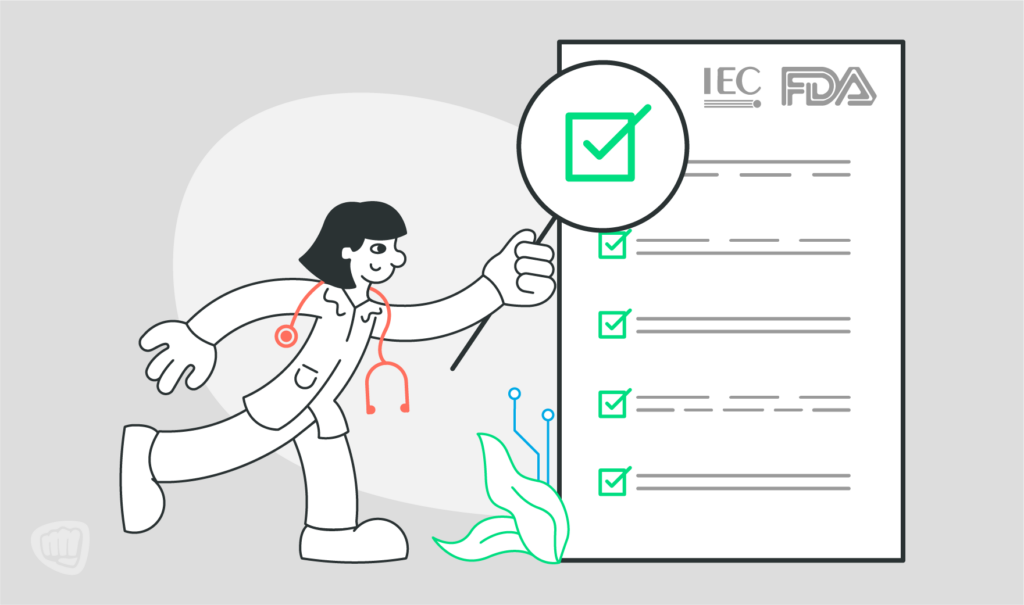Building regulatory-compliant software for connected medical devices isn’t just a matter of process, it’s a matter of system-level execution across architecture, risk management, and validation. At Punch Through, compliance is treated as an operational discipline from the outset, engineered into how we design, implement, and evolve connected solutions for MDDS, Class II, and Class III devices.
In a space where reliability is non-negotiable and clinical risks are real, we build software that’s engineered to hold up — technically, clinically, and regulatorily.
Our approach to regulatory-ready software development focuses on:
- Embedding compliance into system architecture from the start to minimize rework and documentation gaps.
- Aligning development processes to device classification and submission pathway requirements.
- Integrating IEC 62304 standards without slowing architectural flexibility or iteration.
- Building documentation that directly supports regulatory defensibility and V&V execution.
- Structuring early risk management, traceability, and verification planning across the full product ecosystem.
Compliance is Engineered In, Not Layered On
Regulatory alignment starts at the architecture level. IEC 62304 requirements directly shape how software modules are partitioned, how interfaces are defined, and how risk control measures are implemented and documented. Every architectural decision must withstand later scrutiny, not only for functional performance but also for regulatory defensibility.
We engineer compliance into the earliest design phases by:
- Structuring system architecture around defined software item classifications and safety-critical boundaries.
- Embedding risk controls directly into module interfaces and communication layers.
- Building traceability frameworks that align requirements, design outputs, and verification activities from the outset.
This proactive structure minimizes late-stage rework, closes documentation gaps, and ensures that design, implementation, and regulatory needs progress in lockstep.
Navigate Classification Complexities for MDDS, Class II, and Class III Devices
Each device classification, whether MDDS, Class II, or Class III, drives distinct development and documentation requirements. Regulatory pathways such as 510(k), IDE, or PMA further nuance those expectations based on intended use, risk profile, and clinical significance.
We calibrate development practices to match each product’s classification and submission pathway by:
- Scaling hazard analysis depth, documentation rigor, and verification independence according to device class and intended use.
- Tailoring design control activities to meet the specific demands of therapeutic, diagnostic, or monitoring system claims.
- Aligning traceability matrices and risk documentation to satisfy the expectations of 510(k), IDE, or PMA review processes.
This approach ensures that process rigor fits device complexity from the outset, avoiding overbuilding, underbuilding, or regulatory misalignment that can delay submission.
Integrate Standards Without Disrupting Agility
IEC 62304 compliance is embedded into our engineering flow, not layered on top of it. We structure change control, configuration management, and formal verification to move with the development cycle, rather than slowing it down.
By integrating lightweight, auditable checkpoints into Agile iterations, we preserve speed without sacrificing traceability. Architectural flex is protected by defining critical baseline elements early—interfaces, data integrity measures, and safety classifications—allowing controlled adaptation without jeopardizing regulatory alignment. This balance keeps clinical and market needs evolving without creating compliance debt that must be paid down later.
Build Documentation that Stands Up to Review
Submission readiness isn’t just about having documents, it’s about producing documentation that clearly, coherently, and systematically demonstrates design controls, risk management, and validation.
Punch Through documentation strategies emphasize traceability without unnecessary bloat. From requirements and design descriptions to test reports and risk analyses, every artifact is developed with both engineering clarity and regulatory auditability in mind. Our teams avoid common pitfalls like disjointed trace matrices, incomplete hazard mitigations, or unverified design outputs that often trigger submission deficiencies.
By focusing on coherent document chains rather than isolated deliverables, we ensure regulatory reviewers can follow the full design and risk logic without gaps or ambiguities.
Avoid Common Compliance Bottlenecks
Connected medical product teams often encounter hidden traps that stall or derail regulatory readiness. Some of the most critical include:
- Risk controls implemented but not traceably verified.
- Software versions drifting without documented configuration management.
- Insufficiently justified changes during Agile iterations.
- Architectural decisions lacking documented risk rationale.
Punch Through’s development practices preempt these traps by engineering traceability, risk linkage, and configuration integrity directly into the day-to-day development cycle and not relegating them to periodic audits or end-of-project scrambles.
Design for Predictable V&V and Submission Readiness
Gaps in traceability, ownership, or architecture don’t just slow development, they cascade into late-phase integration issues, testing failures, and regulatory documentation gaps. We structure development to surface and resolve these risks early, reducing rework and building stronger alignment between design, implementation, and verification from the start.
We focus on:
- Defining user needs, design inputs, and traceability frameworks early to prevent drift.
- Identifying critical path risks tied to architecture, safety, and compliance.
- Structuring clear ownership and interfaces across embedded, mobile, and cloud systems.
- Building verification strategies that validate readiness, not just functionality.
By embedding these practices into the development cycle, we help connected medical products move into V&V and regulatory submission with fewer surprises, stronger documentation chains, and greater confidence in closure.
Proven Expertise Across Regulatory Pathways
Our regulatory experience spans devices that have successfully navigated 510(k), IDE, and PMA pathways. We’ve built software that anchors critical therapeutic, diagnostic, and monitoring systems, including solutions where real-time wireless data, embedded firmware, mobile applications, and cloud systems all intersect under regulatory scrutiny.
This system-level expertise means we don’t just meet baseline compliance, we anticipate and design for the nuanced challenges connected ecosystems present to regulatory reviewers. Security, data integrity, interoperability, and update mechanisms are all integrated into the compliance model from the outset.
We’re Regulatory-Ready by Design
Punch Through embeds compliance into how we design, develop, and validate software—structured from the outset to support traceability, risk management, and verification requirements. By integrating compliance into every phase of development, we help clients move toward submission with stronger validation, clearer documentation, and greater confidence in closure. Our disciplined approach not only supports faster, more predictable regulatory submissions, but also reduces long-term risk, strengthens technical defensibility, and positions connected products for lasting success in the market.
We are not a regulatory consultancy: While we design and build software aligned with regulatory requirements, Punch Through does not provide regulatory consulting or serve as a QA/RA firm. We focus on delivering software that meets the technical and documentation standards needed to support successful regulatory submissions.




